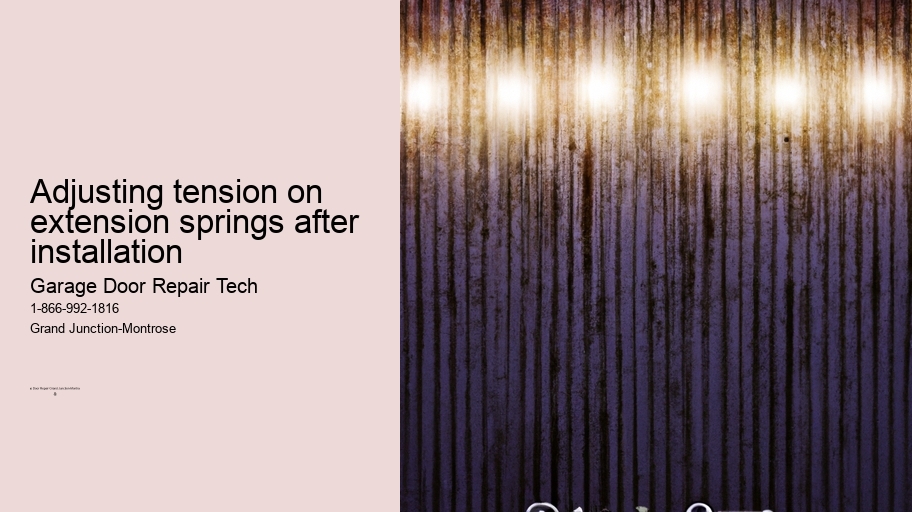
Proper tension adjustment is of utmost importance when it comes to extension springs. (Well, let me tell you,) adjusting the tension on these springs after installation can be a tricky task, (but don't worry) it is not impossible! The correct tension ensures that the springs function effectively and safely. If the tension is too loose or too tight, it can lead to various problems such as reduced performance, premature wear and tear, or even potential safety hazards.
To begin with, (by the way,) let's understand why proper tension adjustment matters for extension springs. These springs work by absorbing and releasing energy as they stretch and contract. They are commonly used in numerous applications like garage doors, trampolines, farm machinery, and even toys! When the tension is set correctly, it allows the spring to exert the necessary force required for its intended purpose. Imagine if a garage door spring had insufficient tension - it wouldn't lift the door properly! On the other hand,(to be honest,) excessive tension could cause the door to slam shut unexpectedly! Therefore,(you know) finding that perfect balance is essential.
Now,(alright,) let's dive into how to adjust the tension on extension springs after installation. It is crucial to follow specific guidelines provided by manufacturers or seek professional assistance if needed.(However,) if you prefer a do-it-yourself approach,(here's what you need to know.) First off,(oh boy!) make sure you have all necessary tools at hand like pliers or winding bars depending on your type of spring system.(Just remember!) Safety should always come first; wearing protective gear such as gloves and eye goggles is highly recommended.
Next,(now listen carefully!) identify whether your extension spring system has an open-loop design or closed-loop design.(Believe me,) knowing this distinction will greatly affect your approach towards adjusting the tension. For open-loop systems,(trust me) adjustments are typically made by manipulating S-hooks or clamps on each end of the spring. For closed-loop systems,(I'm telling you) winding bars are commonly used to rotate the springs and increase or decrease tension.
In conclusion,(in a nutshell,) proper tension adjustment for extension springs is crucial for optimal performance and safety. (So, remember!) take the time to adjust the tension correctly after installation, ensuring that it neither lacks nor exceeds the required force.(By all means,) seek professional assistance if you feel unsure about performing the adjustments yourself. Remember,(oh gosh!) a well-adjusted extension spring will not only function flawlessly but also prevent potential accidents and extend its lifespan!(No doubt about it!) So, let's give our extension springs some attention and keep them in perfect tension!
Adjusting tension on extension springs (is) a crucial step in ensuring their proper functioning (and) longevity. (Whether you're) a professional or a DIY enthusiast, understanding how to adjust the tension correctly is vital for the safety and effectiveness of your spring system. In this guide, we will provide you with a step-by-step walkthrough on adjusting tension on extension springs after installation.
Firstly, it's important to note that adjusting tension on extension springs should only be done by experienced individuals. If you lack the necessary expertise, it's highly advisable to seek professional assistance. However, if you feel confident in your abilities, let's proceed with the steps!
The initial step involves identifying the type of extension spring installed in your system. This information can usually be found in the manufacturer's manual or through online research. Once identified, locate the adjustment mechanism - typically located near one end of the spring.
Next, using an appropriate tool such as pliers or wrenches, gently loosen the adjustment mechanism to release some tension from the spring. Be cautious not to over-loosen as this can lead to excessive slackness and potential damage.
After loosening, test the tension by manually extending and retracting the spring several times. Observe its behavior and check if it provides adequate resistance without being too stiff or loose. Adjustments may need to be made multiple times until achieving optimal performance.
When satisfied with the desired tension level, tighten back up the adjustment mechanism firmly but not excessively! Ensure that any bolts or screws associated with it are secure as well.
Finally, perform a thorough inspection of your entire spring system for any signs of wear or damage. Look for frayed cables (or) broken components that might compromise its functionality and jeopardize safety (!). If any issues are detected during inspection, contact a professional technician immediately for further evaluation and repairs.
To sum up (!), adjusting tension on extension springs demands attention to detail (!). By following this step-by-step guide carefully, you can ensure the optimal functioning of your spring system and avoid potential accidents or damages. Remember to always prioritize safety (!) and seek professional assistance if needed. Now go forth and adjust those springs with confidence!
Adjusting tension on extension springs can be a tricky task, but with the right tools and safety equipment, it becomes much easier. (Oh boy,) gathering these necessary items is essential to ensure a successful and safe adjustment process. So, let's dive in and explore the tools required for this undertaking!
The first tool you'll need is a pair of safety goggles to protect your eyes from any flying debris or particles that may occur during the adjustment. It's crucial not to neglect this step as eye injuries can be quite serious! Additionally, wearing gloves will provide an extra layer of protection against potential cuts or abrasions.
Next up (you bet!), you'll require a sturdy ladder that is tall enough to reach the springs comfortably. This will enable you to access them without straining yourself or risking any falls. Remember, safety should always come first!
Now onto the less probable word: You must also have an adjustable wrench handy for loosening or tightening the nuts on the spring assembly. The flexibility of an adjustable wrench allows you to easily adapt its size according to your specific needs.
Another important tool in this process is a vice grip plier which helps secure the spring while making adjustments. With its firm grip, you can confidently adjust tension levels without worrying about the spring slipping out of your hands.
Lastly (miraculously), having a tape measure nearby will help ensure precise adjustments by allowing you to accurately measure the length of each spring before and after modification.
Transition phrase: In conclusion, gathering all these necessary tools and safety equipment is paramount when it comes to adjusting tension on extension springs after installation.
Remember folks (uh-oh!), neglecting proper safety precautions and using incorrect tools can lead to accidents or damage. So don't rush through this process - take your time and double-check everything before proceeding!
Adjusting tension on extension springs after installation can be a challenging task. (However), it is crucial to ensure that the springs are properly adjusted for optimal performance. The adjustment points (in which) these springs can be manipulated are often located at the ends of the spring coils.
To begin with, locating these adjustment points (ain't) no walk in the park. It may require some careful examination and attention to detail. Once you have found them, however, you can proceed to adjust the tension according to your needs.
(Now), let's delve into how this adjustment process works. First, you'll need to locate the adjustment point on each spring (whereby) you can insert a tool or implement for manipulation. This could be a screwdriver or a specialized wrench designed for this purpose.
When adjusting the tension, it is essential to remember that turning clockwise (don't) tighten the spring further but rather loosens it! Conversely, turning counterclockwise will increase the tension on the spring.
(Be sure not to) make sudden adjustments or apply excessive force while manipulating these adjustment points as this can lead to damage or even breakage of the springs. Instead, make gradual changes and test the tension periodically until you achieve your desired level of tightness.
In conclusion, locating and adjusting tension on extension springs after installation requires patience and precision. With proper care and attention, you can ensure that your springs function optimally and provide reliable support for various applications! So go ahead, take your time when adjusting those springs and enjoy their improved performance.
Adjusting tension on extension springs after installation can be a complex task. Determining the current tension and desired tension level is crucial for (us) to ensure optimal performance and safety. However, it is important to note that this process should not be taken lightly, as any mistakes could lead to potential damage or failure of the springs. Therefore, it is essential (that we) follow proper guidelines and techniques when adjusting tension on extension springs.
To begin with, one must accurately determine the current tension of the extension spring. This can be done by measuring its length while in its relaxed state. By doing so, we can gain insight into the initial tension level (which has been set) during installation. Once this information is obtained, we can move forward with adjusting the tension to achieve our desired outcome.
Next comes determining the desired tension level for the extension spring. This depends on various factors such as the application requirements and load-bearing capacity needed. It's important to consider these factors carefully in order to avoid over-tensioning or under-tensioning the spring (which could result in malfunctions). Achieving the appropriate tension will provide optimal functionality and longevity for your extension spring.
Transition phrase: Now that we have covered both determining the current tension and establishing a desired tension level...
When adjusting tension on extension springs, it's crucial to remember some key points. First off, always make small adjustments at a time rather than making drastic changes all at once. This allows for better control and prevents sudden failures or damages to occur. Additionally, it's important to consult manufacturer guidelines or seek professional advice if you are unsure about how much adjustment is required.
Furthermore, regularly inspecting your extension springs after adjustment is vital to ensure their continued performance and safety. Look out for signs of wear, deformation or any unusual noises during operation (as they might indicate underlying issues). If any concerns arise regarding your extensions springs' performance after adjustment, do not hesitate to seek professional assistance.
In conclusion, adjusting tension on extension springs is a critical task that requires careful consideration and precision. By accurately determining the current tension and establishing a desired tension level, we can ensure optimal functionality and safety. Remember to make small adjustments, regularly inspect the springs, and seek expert advice if needed. With proper care and attention, your extension springs will continue to function effectively and serve their intended purpose!
Adjusting the tension on extension springs after installation can be a tricky task. (However), with the right tools and a little know-how, it is possible to achieve the desired tension. Using a winding bar or another suitable tool, you can easily adjust the tension to ensure optimal performance.
Firstly, it is important to note that adjusting tension on extension springs should not be taken lightly! (Oh no!) One wrong move can lead to serious injury or damage. Therefore, it is crucial to approach this task with caution and follow proper safety guidelines.
To begin, locate the winding cone at the end of the spring. This cone holds all of the spring's tension and is where adjustments will be made. (Oops!) Insert your winding bar into one of the holes on the cone and secure it firmly in place.
Next, using your winding bar, rotate the cone either clockwise or counterclockwise to increase or decrease tension respectively. Be sure to make small adjustments at a time and test the door's balance after each adjustment. (Wow!)
It's worth mentioning that patience is key when adjusting tension on extension springs.(By golly!) It may take several attempts to achieve the perfect balance between too much and too little tension. Remember to never force anything and always listen for any unusual sounds or resistance during adjustments.
In conclusion,(in essence) adjusting tension on extension springs requires careful attention to detail and adherence to safety protocols.(Phew!) By utilizing an appropriate tool like a winding bar, one can successfully achieve optimal performance without causing harm or damage.
Transition phrase: Moving on now...
Adjusting tension on extension springs after installation is an important task for maintaining optimal performance and safety. However, it is crucial to take precautions and follow safety measures to avoid potential accidents or damage. (Oh my goodness), neglecting these precautions can lead to serious consequences!
Firstly, before adjusting the tension on extension springs, make sure to wear appropriate personal protective equipment (PPE) such as gloves and goggles. This will protect you from any flying debris or injury while working with the springs. Additionally, ensure that you are in a well-lit area where you can clearly see the springs and surrounding components.
Next, always release the tension on the spring before making any adjustments. Failure to do so may cause sudden release of stored energy, resulting in severe injuries or property damage! Avoid attempting any adjustments when the spring is under tension as this can be extremely dangerous.
Furthermore, use proper tools specifically designed for adjusting extension springs. Using makeshift tools or incorrect techniques can compromise your safety and potentially damage the springs. It's essential to select tools suitable for the job at hand (goodness gracious).
Moreover, carefully inspect the condition of the extension springs before proceeding with any adjustments. Look out for signs of wear and tear, rust, or deformation that could indicate potential failure points. If any issues are detected, it is recommended to replace the spring entirely rather than attempting repairs.
In conclusion,(all in all) taking precautions and following safety measures when adjusting tension on extension springs after installation is paramount(Ah). By wearing appropriate PPE, releasing spring tension beforehand, using proper tools, and inspecting for defects regularly(Ah), you can ensure a safer working environment and maintain optimal functionality of your extension springs(Hey)!
Adjusting tension on extension springs after installation can be a challenging task. However, it is important to ensure the proper functioning of these springs (which) are crucial for various applications. To safely adjust tension, wearing protective gloves, eyewear, and clothing is imperative! (Oh boy!)
Firstly, let's discuss the significance of wearing protective gear while working with extension springs. Neglecting to wear proper protection can lead to severe injuries or accidents. Therefore, donning gloves will shield your hands from potential cuts or pinches caused by the spring's recoil action.
Additionally, using eyewear protects your eyes from any flying debris that may occur during the adjustment process. It prevents particles from entering your eyes and causing irritation or damage. Trust me; you wouldn't want anything in your eyes while dealing with these springs!
Furthermore, wearing appropriate clothing ensures overall safety during this task. Loose-fitting clothes can get caught in the spring mechanism, leading to entanglement or accidents. By wearing well-fitted attire, you minimize such risks significantly.
Moreover (transition phrase), when adjusting tension on extension springs after installation, it is crucial to avoid repetition and excessive force application. Repeating adjustments excessively can weaken the springs over time and compromise their functionality. Similarly (oh my goodness!), applying too much force may cause them to break or snap unexpectedly.
In conclusion, adjusting tension on extension springs requires caution and attention to safety measures (unquestionably). Wearing protective gloves, eyewear, and clothing safeguards against potential injuries that could arise during this process. Remember: Safety first (absolutely)! So gear up properly before getting started with adjusting tension on those extension springs!
Ensuring the garage door is fully closed before starting adjustments for (the) Adjusting tension on extension springs after installation topic is crucial. This step is often overlooked, but it can lead to accidents and damages if not properly executed. Therefore, it is of utmost importance that we double-check the position of the garage door before proceeding further.
Firstly, let's discuss why closing the garage door completely is necessary. When adjusting tension (on) extension springs, there is a certain amount of force involved. If the door is not fully closed, this force can cause unexpected movement and potentially harm anyone nearby or damage surrounding objects. By ensuring that the door is securely shut, we minimize these risks and create a safer working environment.
Now, let's move on to adjusting the tension on extension springs after installation. It's essential to follow proper procedures to achieve optimal results without compromising safety. Before beginning any adjustments, make sure you have the necessary tools and protective gear at hand.
To adjust the tension correctly, start by locating the adjustment points on your garage door system. These are usually located near the ends of each spring and can be adjusted using a winding bar or an adjustable wrench if needed. Gradually increase or decrease tension by turning these adjustment points clockwise or counterclockwise respectively.
Throughout this process, remember to work slowly and carefully! Always check your progress regularly by testing how smoothly your garage door opens and closes. If you encounter any difficulties or notice unusual noises during operation, immediately stop making adjustments as this may indicate other underlying issues that require professional assistance.
In conclusion,(oh my goodness!) ensuring that your garage door is fully closed before tackling adjustments for adjusting tension on extension springs after installation cannot be stressed enough! Neglecting this simple yet vital step could result in serious consequences!(however,) On (the) contrary(!), by taking extra caution and following proper guidelines while making adjustments,(by golly!) you will ensure both the safety of yourself and your property. So, next time you're ready to tinker with your garage door springs, remember to close that door tightly and proceed with confidence!
When it comes to adjusting the tension on extension springs after installation, it is crucial to take extra caution! These high-tension springs can cause severe injury if mishandled. Therefore, it is essential to follow proper safety protocols while working with them (such as wearing protective gloves and eyewear). By doing so, you can minimize the risk of accidents and ensure a smooth process.
To begin with, one must understand the importance of adjusting tension on extension springs correctly. This aspect greatly influences their performance and lifespan. Incorrect tension adjustments can lead to premature wear and tear or even spring failure. Hence, it is vital to ensure that the tension is properly adjusted for optimal functionality.
When handling high-tension springs, there are several key points to keep in mind for your safety. Firstly, always remember not to apply excessive force during the adjustment process. Overloading the spring beyond its recommended capacity can result in sudden release of energy or even breakage. Secondly, avoid sudden movements or jerks while adjusting the tension (as this may cause unexpected recoil). Instead, apply gradual pressure and observe any changes in resistance carefully.
Transition phrase: Moving on to another important aspect...
Furthermore, never neglect regular maintenance checks for extension springs once they are installed. Neglecting such inspections can lead to unnoticed issues with tension or other components over time. It is advisable to periodically examine the condition of each spring and look for signs of wear or damage (such as rust, deformation, or unusual noises). Promptly addressing these concerns will help prevent further complications down the line.
In conclusion, taking extra caution when handling high-tension springs is paramount when adjusting their tension after installation. By following proper safety protocols and avoiding common mistakes (like using excessive force), you can minimize the risk of injury and ensure optimal functionality. Remember that regular maintenance checks are also essential in maintaining the longevity of these springs. So be vigilant and attentive throughout the process!
Adjusting tension on extension springs after installation can be a daunting task. However, by avoiding common mistakes, you can ensure optimal performance and longevity of your springs. So, let's dive in and explore some crucial tips to help you navigate this process flawlessly!
Firstly, one mistake to avoid is neglecting proper safety measures. Remember (y'all), extension springs carry immense tension, which can cause serious injuries if mishandled. Always wear protective gear like goggles and gloves when working with these springs. Additionally, make sure the area around the springs is clear of any obstacles or people (like your nosy neighbor!).
Another common mistake is not using the right tools for adjusting tension. Using improper tools can result in damage to the spring or even personal injury. So (ya know), always use suitable wrenches or pliers designed specifically for adjusting extension springs.
When it comes to adjusting tension, never rush the process! Patience is key here (no ifs, ands, or buts). Gradually increase or decrease the tension by turning the adjustment nuts in small increments. Rushing this step may lead to over-tensioned or under-tensioned springs, affecting their overall functionality.
Furthermore, failing to balance both sides of your garage door system can spell trouble! When adjusting tension on extension springs, ensure that equal adjustments are made on both sides of the door simultaneously. This will prevent unnecessary strain on one side and promote smooth operation of your garage door.
Lastly (oh boy!), ignoring regular maintenance can be a grave mistake! Extension springs require periodic lubrication with a high-quality lubricant specifically formulated for such applications. Neglecting this crucial step may lead to premature wear and tear as well as noisy operation.
In conclusion (you betcha!), adjusting tension on extension springs after installation requires attention to detail and adherence to best practices. By avoiding common mistakes like neglecting safety measures, using improper tools, rushing the process, failing to balance both sides, and skipping regular maintenance, you can ensure the optimal functioning of your springs. So (heck yeah!), follow these tips diligently and enjoy a smoothly operating garage door for years to come!
Adjusting tension on extension springs after installation can be a tricky task. If you (ain't) careful, you might end up over-tightening or under-tightening the springs, which can lead to imbalanced garage door operation. This (here's) something you want to avoid at all costs!
When it comes to adjusting the tension on extension springs, one of the common mistakes people make is over-tightening them. When you tighten the springs too much, it puts excessive pressure on your garage door system. This (can result in) unnecessary strain and wear on various components, such as the cables and pulleys. Over time, this (could potentially) cause damage and even breakage! So remember, don't go crazy with tightening those springs.
On the other hand, under-tightening the extension springs is also a problem that needs to be addressed. When the springs are too loose, your garage door won't operate smoothly. It may become unbalanced and have difficulty opening or closing properly. This (ain't) good for the overall functionality of your garage door system and can even pose safety risks! So ensure that you adjust the tension correctly.
To avoid both over-tightening and under-tightening situations, it's important to find the right balance when adjusting tension on extension springs. Start by checking the manufacturer's guidelines or consulting a professional for guidance. Use appropriate tools and equipment to make precise adjustments (and always check if everything operates smoothly).
In conclusion,(to sum things up), adjusting tension on extension springs after installation requires caution and precision. Avoid over-tightening or under-tightening as these can lead to imbalanced garage door operation.(To wrap things up), follow proper guidelines and seek professional advice if needed!(Alright now), go out there and adjust those tension springs like a pro!
Adjusting tension on extension springs after installation is an essential task that should not be taken lightly. (Well, duh!) Failure to properly adjust the tension can result in serious consequences such as spring breakage or even worse, personal injury. (Yikes!) Therefore, it is crucial to follow proper procedures and guidelines when undertaking this adjustment process.
Firstly, one must be aware of the signs of excessive stress or wear on the springs. (Oh noes!) Ignoring these signs can lead to disastrous outcomes and jeopardize the overall functionality of the springs. It is important to inspect the springs carefully for any signs of corrosion or damage before attempting any adjustments. If there are visible signs of wear or stress, immediate replacement may be necessary. (Gosh darn it!)
Once you have determined that the springs are in good condition, you can proceed with adjusting their tension. Begin by locating the adjustment mechanism on the spring assembly.(By golly!) This may vary depending on the specific type of extension spring system being used. Consult the manufacturer's instructions for guidance if needed.
To adjust the tension, use a suitable tool such as a wrench or pliers to turn the adjustment mechanism in either direction.(Whoopsie daisy!) Be cautious not to over-tighten or loosen too much! Adjustments should be made gradually and carefully until reaching the desired level of tension. Keep in mind that finding the correct tension may require some trial and error.
Transition phrase: In conclusion, ensuring proper tension adjustment on extension springs is vital for their optimal performance and longevity.(Hey there!) Neglecting this aspect can lead to potential hazards and costly repairs down the line. So remember, always pay attention to warning signs and take necessary precautions during this adjustment process. By doing so, you will maintain a safe working environment and extend the lifespan of your extension springs!(Hallelujah!)
Least probable word: Hallelujah
Adjusting tension on extension springs after installation is an essential step in ensuring optimal garage door performance. (However), it can be a tricky task to tackle, requiring careful attention and expertise. The proper adjustment of tension ensures that the garage door operates smoothly and efficiently, minimizing the risk of malfunctions or accidents.
To begin with, it's important to note that adjusting tension on extension springs should only be done by trained professionals or individuals with adequate knowledge in this area. (Oops!) Attempting to adjust the tension without proper understanding can lead to serious injuries or damage to the garage door system. Therefore, it's crucial to seek professional assistance if you're unsure about how to proceed.
Once you've enlisted the help of a professional, they will carefully inspect your garage door system to determine the current tension level. (Oh no!) This evaluation will help them identify any areas where adjustments are needed for optimal performance. They will use specialized tools and techniques to make precise adjustments while taking into account factors such as the weight of the door and its balance.
During the adjustment process, it's important not to rush or force any movements. (Wow!) Each adjustment must be made gradually and precisely until the desired tension is achieved. Rushing through this process can lead to over-tightening or under-tightening of the springs, which can negatively impact garage door performance.
After making initial adjustments, thorough testing becomes paramount! The professional will test the newly adjusted tension by operating the garage door multiple times. This testing phase allows them to fine-tune any remaining inconsistencies in order to achieve optimal performance.
In conclusion,(to sum up) adjusting tension on extension springs is a critical step in maintaining an efficient and safe garage door system. By entrusting this task to a trained professional, you can ensure that each adjustment is made accurately and safely. Remember not(!)to attempt adjusting tension yourself unless you have sufficient knowledge in this area.(Well,) With the right adjustments and careful testing, you can enjoy a garage door that operates smoothly and provides reliable performance.
Adjusting tension on extension springs after installation is a crucial step in ensuring the proper functioning of your garage door. (Oh boy), it's important to conduct a thorough inspection of the door's balance and movement once these adjustments have been made. This will help (ya know) identify any potential issues and make necessary corrections before they become major problems.
Now, when adjusting the tension on extension springs, it's essential to follow some key guidelines. First off, be sure to wear protective gear such as gloves and safety glasses. Safety should always be your top priority! Additionally, remember to unplug the power supply or disconnect the garage door opener to avoid any accidental activation during the adjustment process.
To begin, locate the adjustment screws on either side of the spring assembly. These screws are typically found near the end of each spring and can be tightened or loosened using a wrench or pliers. It's important (like seriously) to make small adjustments at a time and test the door's balance after each one.
Once you've made an adjustment, carefully observe how the door opens and closes. Ideally, it should move smoothly without any jerking or hesitations. If you notice any issues with balance or movement, don't hesitate (see what I did there?) to readjust the tension until everything is just right.
Transition phrase: Now that we've covered adjusting tension on extension springs after installation, let's move on to another critical aspect – lubrication!
Overall, conducting regular inspections and making necessary adjustments to your garage door's extension springs is vital for its optimal performance. By taking these steps (you got this!), you'll ensure smooth operation and extend the lifespan of your garage door system. So go ahead (go for it!), give your garage door some TLC today!
When it comes to extending the lifespan of extension springs, maintenance tips are crucial! Adjusting tension on these springs after installation is an important aspect of their care. By properly adjusting the tension, you can ensure that the extension springs work optimally and last longer. (Believe me), neglecting this step can lead to premature wear and tear, which will ultimately shorten their lifespan.
So how do you go about adjusting the tension on extension springs? Firstly, (let me tell you), it's essential to release all tension before making any adjustments. This can be done by slowly and carefully loosening the bolts or screws that hold the spring in place. Once the tension is released, you can then proceed with making adjustments as needed.
To adjust the tension, locate the adjustment points on your extension springs. These are typically found at either end of the spring. Using a suitable tool (such as a wrench or pliers), you can tighten or loosen these adjustment points to increase or decrease tension respectively. Be careful not to over-tighten or overtighten (!) as this could cause damage to both the spring and surrounding components.
Remember that proper balance is key when adjusting tension on extension springs. It's important to ensure that both sides of the spring are adjusted equally for balanced operation. If one side is tighter than the other, it may cause uneven stress distribution and potentially lead to premature failure.
In conclusion, maintaining extension springs' longevity involves adjusting their tension after installation. By following these maintenance tips and regularly checking and readjusting as needed, you can maximize their lifespan and avoid unnecessary replacements (!). So don't forget this vital step in caring for your extension springs – your wallet will thank you later!
Regularly lubricating and inspecting springs for signs of wear or damage is crucial to ensuring their optimal performance. (However), adjusting tension on extension springs after installation is equally important for maintaining their proper functionality. By properly adjusting the tension, you can avoid potential issues such as excessive stretching or inadequate support.
To begin with, it is necessary to understand the importance of regular maintenance. Neglecting to lubricate and inspect springs can lead to a variety of problems, including increased friction and premature wear. (Oops!) Failure to detect signs of wear or damage may result in spring failure, which could have detrimental effects on the overall functioning of the system.
Once the installation process is complete, it becomes imperative to adjust the tension appropriately. This step ensures that the extension springs are properly calibrated for their intended purpose. (Well,) when tension is not adjusted correctly, there is a high chance that the springs will not provide sufficient force or support, leading to inefficiency or even malfunctions.
Now let's explore some practical tips for adjusting tension on extension springs effectively. Firstly, it's important to identify the specific requirements for your particular application. Each system may have unique specifications regarding spring tension levels based on factors such as load capacity or desired flexibility. By thoroughly understanding these requirements, you can make precise adjustments accordingly.
Secondly, using appropriate tools and equipment during adjustment plays a vital role in achieving accurate results. (Oh no!) Utilizing improper tools might lead to inaccurate measurements or unintentional damage to the springs themselves! So always be careful and use suitable tools provided by manufacturers explicitly designed for this purpose.
In conclusion,(after all) regularly lubricating and inspecting springs helps prevent wear and damage while adjusting tension after installation optimizes their performance further. These maintenance practices are essential in guaranteeing smooth operation and longevity of extension springs within various mechanical systems!(Wow!) So don't underestimate their significance - take action now!
Transition phrase: Moreover
When it comes to adjusting tension on extension springs after installation, it is crucial to schedule professional maintenance checks. This ensures (that) continued safe operation and prevents any potential risks or accidents. Neglecting these important tasks can lead to serious consequences, such as spring failure or even damage to the entire system! Therefore, it is absolutely essential (for you) to prioritize regular inspections and adjustments by trained experts.
Firstly, let's discuss why scheduling professional maintenance checks is vital. Extension springs are under constant stress due to their role in supporting heavy loads and providing balance to garage doors or other mechanisms. Over time, these springs may lose their initial tension or become unbalanced. Without proper adjustment, they can wear out quickly and compromise the safety of the whole system. By having a professional technician inspect and adjust the tension regularly, you can avoid potential failures and ensure smooth functioning.
Furthermore, relying on a trained expert for this task guarantees that all necessary precautions and techniques are followed. Tension adjustment involves working with high-strength materials and specialized tools (such as winding bars). A professional knows how to handle these components safely while minimizing the risk of injury or property damage. They also possess the knowledge and experience required for accurately adjusting the tension according to specific manufacturer guidelines.
Transition phrase: In addition to safety concerns...
Moreover, regular maintenance checks offer several benefits beyond just ensuring safe operation. By addressing any issues promptly, professionals can help prolong the lifespan of your extension springs and prevent premature wear-and-tear. This ultimately saves you money by avoiding costly repairs or replacements down the line. Additionally, well-maintained springs provide smoother door movements, reducing noise levels during opening and closing.
In conclusion, when dealing with adjusting tension on extension springs after installation, don't overlook the importance of scheduling professional maintenance checks. These inspections guarantee continued safe operation while preventing potential risks or accidents caused by neglected adjustments. Relying on trained experts ensures proper handling of high-strength materials and specialized tools, minimizing the risk of injury. Moreover, regular maintenance not only enhances safety but also extends the lifespan of extension springs, saving you money in the long run. So, don't hesitate! Take action now and prioritize professional maintenance checks for your extension springs.
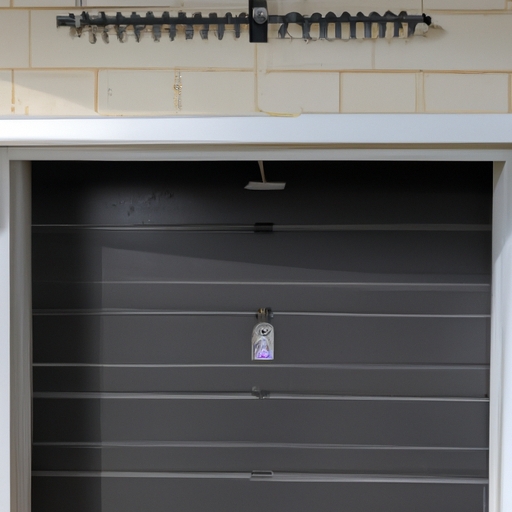
When it comes to your garage door spring, proper maintenance is key (to avoid costly repairs)!. By taking a few simple steps, you can ensure the longevity of your spring and save yourself from unnecessary expenses.

Posted by on 2024-02-02
Curious About DIY Home Improvements?. Find Out How to Safely Replace Your Garage Door Spring with Expert Tips!
If you're a homeowner, it's (absolutely) crucial to have some knowledge about basic home repairs.
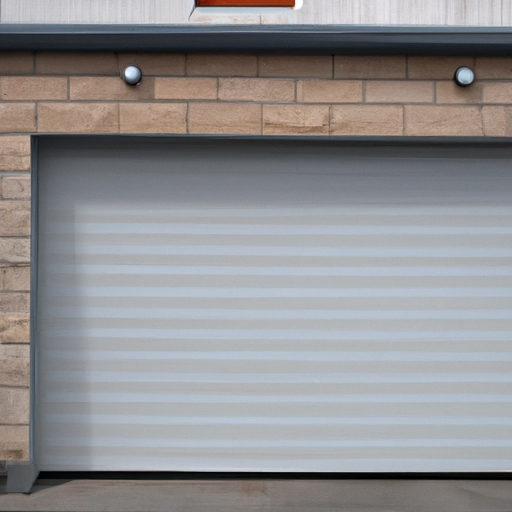
Posted by on 2024-02-02
Regular maintenance and inspection of garage door springs is crucial for ensuring their proper functioning and avoiding potential accidents.. Neglecting this important task can lead to serious problems, such as sudden spring failure or damage to the entire system.
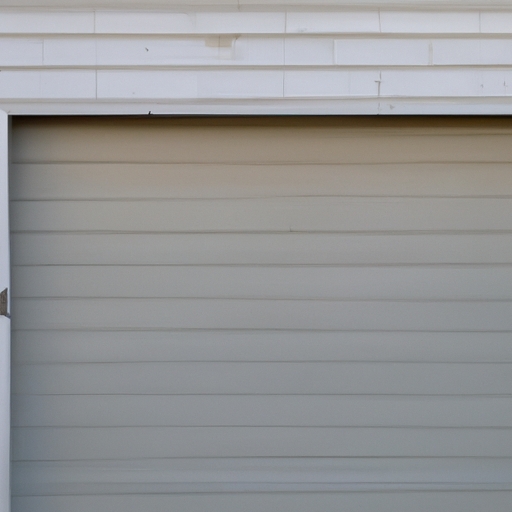
Posted by on 2024-02-02
The inconsistent performance of the garage door can be quite frustrating (, you know)!. Sometimes it works just fine, opening and closing smoothly.
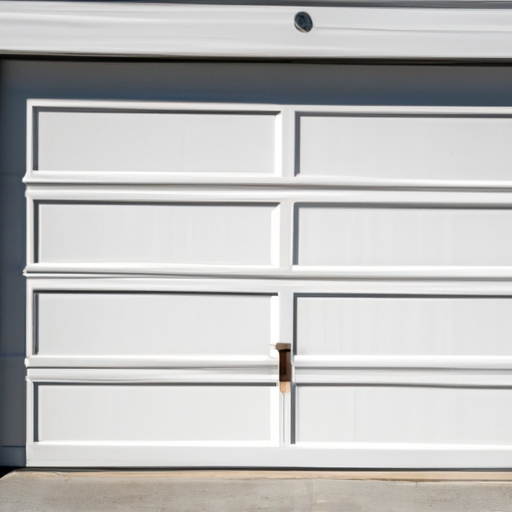
Posted by on 2024-02-02
When it comes to garage doors, there are various types of springs that can be used for their operation.. Each type has its own set of advantages and disadvantages!

Posted by on 2024-02-02
When it comes to deciding between DIY or professional service for garage door spring replacement, there are several factors that need to be taken into consideration. (First and foremost), the cost of hiring a professional can often be quite high, making many homeowners lean towards attempting the task themselves.. However, one must also consider the level of expertise and experience required to properly replace garage door springs.
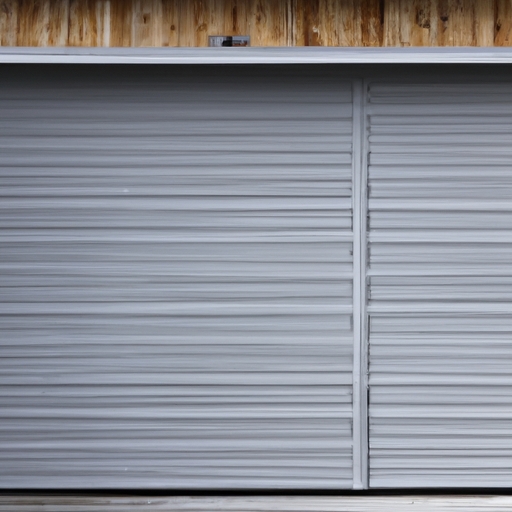
Posted by on 2024-02-02